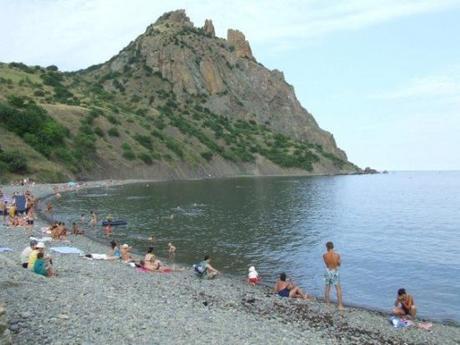Feodosia
Once ancient Cafa, now the south-eastern resort of Crimea; Feodosia measures its age in centuries. Who has this city not seen during its lifetime? The ancient walls of the Feodosian Citadel, spread out on Karantynnyi Hill in the northern part of the city, can remember the Hellenic legends, the formation of Armenian colonies, the deeds of the Genovese, the Turkish invaders and Zaporizhian Cossacks.
The blessed land, a sweet spot, the long dreamed of territory – these words are just as true of modern as of medieval Crimea, which was the patrimony of the Golden Horde. Who knows what the destiny would have been for the small village of Cafa (or Caffa), (founded by the ancient Greeks on the Black Sea coast in the mid 6th century), if merchants from the Italian city of Genoa had not bought it from a Tatar Khan in 1266. The city’s whole epoch full of glory and legends is thanks in no small part to the Genovese. Soon after the Italian’s arrival the golden age of Cafa truly began. It became a large commercial city and a main shipping center for caravans coming to Europe from Central Asia, India and China. Understanding how attractive Cafa was to Tartar invaders, the Genovese built stone walls (12 m high and 2.5 m wide), strengthened with twenty six towers. In the Middle Ages the Genoese Fortress had two lines of defense: the external (with the city inside) and an internal Citadel three times smaller. At the time it was one of the most powerful fortifications in Europe.
Kliment's Tower
However, strong fortress walls did not help the Genovese in their fight with Muhammed II, a Turkish sovereign who drove the Italians from Crimea and turned Cafa into the capital of its Crimean province. The new ruler established control over shipping in the Black Sea, blocking European merchants’ access to it, and the streets of Cafa lost their lively spirit of international trade. Only one thing did not change: Cafa remained Crimea’s main slave-market. From this city captured Ukrainians were sold into slavery to Turkey, Italy and other countries. This is probably why the majority of legends about the Feodosian Citadel are not about ghosts, but about escaping from captivity.
One such story is about beautiful black-eyed Oksana, sold in Cafa into a harem. Zaporizhian Cossack Pavlo, who madly loved the girl, rescued her by changing into a woman who sold dresses and laces. He smuggled Oksana out hidden in a basket of fabrics!
However, the history here is full of incredible events even without the Genovese Citadel. In 1347 the troops of Jani Beg, a khan of the Golden Horde, laid siege to Cafa-Feodosia. They were stopped only by the Black Plague that started in the Tartar camp, and then proceeded to the Consul’s Palace in the Citadel. The Italians left Cafa by ship and spread the plague throughout Europe.
The old fortress walls, silent witnesses of the past, remember the sea campaign to Cafa (1616) of Zaporizhian Cossacks guided by Hetman Petro Sagaidachnyi. The Cossacks captured the stronghold, wiped out 14 thousand Turkish garrisons and released many captives.
The internal fortification of the fortress, the Citadel, is a trapezoid made from lime stone. Once on this land there were palaces, a Catholic bishop’s residence, a treasury, a court, warehouses and shops for valuable commodities: fur, jewelry and silk. But by the end of the 18th century most of the Citadel’s buildings were no longer used and were dismantled. Only the 14th century towers of Clement and Krisco (Christ) along with big chunks of the fortress walls and entrance gates remember the past. The highlight of the city, Konstantin tower (1382-1448) rises at the port.
Near the Citadel several 700 year old Armenian churches remain. Among them is the functioning church of the Iverska Icon of the Blessed Virgin (1348).
However, Feodosia is not only a unique historic place, but also a “citadel” of culture and art. After touring the fortress, visit the Ivan Aivazovsky Feodosian art gallery (2, Galereyna Str.). It represents the largest collection of this prominent seascape painter’s works, which have been exhibited throughout the world. Having built the gallery in 1845, Aivazovsky gave it to his native city as a gift.
And try to see Feodosia through the eyes of Alexander Pushkin who visited this city when he was 20 year old, or Anton Chekhov who saw the sea for the first time here. Who has this city not seen? Add your name to the list of warriors, kings and poets that have roamed this territory and discover the strength and history of the Citadel for yourself.
UIA offers daily flights from Kyiv to Simferopol, as well as direct flights from Berlin to Simferopol (on Tuesdays) and from Frankfurt to Simferopol (on Thursdays and Saturdays). From the Simferopol railway station you can get to Feodosia (112 km) by bus or taxi.




